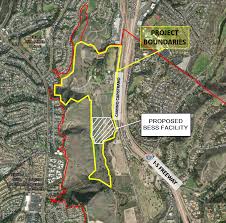by Ed Maurer

A major battle is brewing in San Juan Capistrano over the construction of a large electric battery facility or BESS (Battery Energy Storage System) producing approximately 250 megawatts (MW) of electric energy. This is an important environmental issue pitting local public safety concerns against dire global needs, and Sierra Sage is investigating this complex project while observing the Sierra Club’s policy for siting of renewable energy, transmission, storage, and related infrastructure, last amended by the Board of Directors on May 18, 2024.
The operator of this BESS, Compass Energy Storage LLC, decided to bypass the City of San Juan Capistrano and submitted an application to the California Energy Commission (CEC) in April 2024. The CEC has received a great number of comments from adjacent cities and individuals about this project, most of them in opposition. On May 14, 2024, the CEC determined that the application is incomplete and requested additional information to be produced within 270 days. This gives us time to assess the validity of public safety concerns voiced by the project’s opponents.
The safety concern most often cited by critics is the risk of fire. Lithium-Ion (Li-Ion) batteries pose serious fire risks, and proper protection systems are necessary “to prevent, detect, and mitigate the impact of fires.” Due to the rapid growth of BESS facilities, the number of fires has also increased. When li-ion batteries are stored together there’s a risk for a chain reaction where one battery overheats, catches fire and ignites adjacent batteries. Such an event may lead to explosions and dangerous gases escaping into the environment. Best practices and systems to prevent and detect such fires exist and are in place at extant BESS facilities, which apparently meet CEC and SCAQMD requirements. Read the Hartford Insurance company’s 6 Ways to Reduce Fire Safety Hazards in BESS to learn about fire risk management.
With the planet warming up rapidly, the need for electric energy from battery facilities is indisputable and well documented. Battery storage systems are designed to be charged during daylight hours when renewable energy, especially from solar panels, is plentiful and to discharge this energy after the sun goes down. With this capacity it is possible to begin closing fossil fuel burning power plants that are currently needed to meet California’s demand for electricity, especially from 5 to 9 PM.
This past hot summer has not resulted in any power outages despite triple-digit heat occurring over many days. Dede Subakti, VP Systems Operations of California ISO, the agency that manages the flow of electricity across high-voltage, long-distance power lines to more than 30 million people, in a press release of July 15, 2024, cited “the rapidly growing and high-performing battery fleet that allows us to dispatch power captured during the day from solar, and enhanced communication and coordination, the ISO and our partners in California and the region were able to work through this latest heat event with no power disruptions.”
According to the CEC, the state projects a need for 52,000 MW of battery storage by 2045 with 10,383 (MW) available now. The growth of BESS facilities has been phenomenal in all parts of the state, going from 500 MW provided in 2018 to over 13,000 MW planned to come online by the end of this year.
Many communities allow electric utilities to build such urgently needed battery storage systems, and many are in populated areas such as the one proposed by Compass Energy. It is this cooperative spirit that has made “California a world leader in energy storage with the largest fleet of batteries that store energy for the electricity grid” (CEC).
Here are two BESS projects under construction or in the planning stages:
- What may be the largest BESS facility in the U.S. is expected to be completed in 2025 in Menifee, California. Its 680 MW capacity will be able to provide electric power to 680,000 homes for up to 4 hours. This project is subject to the city code of Menifee and the South Coast Air Quality Management Department (SCAQMD). The closest residential development and public park are about 2,000’ from the BESS facility.
- A BESS project proposed by Southern California Edison (SCE) producing 80 MW is planned for Wildomar, California, and it is going through that city’s approval process. SCAQMD weighed in on November 1 with some recommendations, and the matter is pending. This Chiquito Battery Energy Storage Facility Project is located north of the intersection of Clinton Keith Road and Grand Avenue. Sierra Club hikers pass this site on their way to and from the Santa Rosa Plateau.
The CEC’s website has a survey showing all installed battery storage capacity, and it’s instructive to look at south Orange County, which is devoid of any utility installations so far. Shouldn’t we do our part too, to save future generations from the worst effects of climate change?
The Sierra Club’s siting committee is expected to consult with Sierra Sage soon, and an update on this BESS project will be available by the end of this year.
Related Articles and Links
- California ISO Press Release of July 15, 2024:
- SacBee on Batteries:
- Risk Considerations for Battery Energy Storage Systems
Key Words
Climate Change
Battery Energy Storage Systems